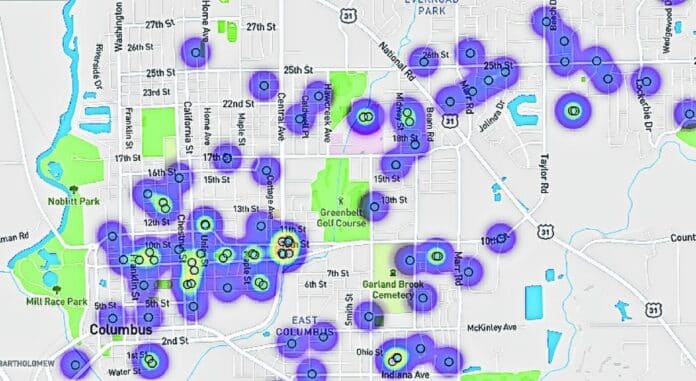
The number of fatal drug overdoses in Bartholomew County has continued to rise in the shadows of the pandemic and is on the verge of matching the 2019 total with three months still left this year.
As of Monday, there had been 23 confirmed overdose deaths in the county, with one suspected fatal overdose still pending toxicology testing, compared to 24 overdose deaths during all of 2019, according to the Bartholomew County Coroner’s Office.
That puts the county on pace for about 34 overdose deaths this year, which would be the highest since at least 2017, when there were 30 deaths.
Additionally, local EMS providers are reporting that they are using naloxone to treat opioid overdoses significantly more often in Bartholomew County in recent months, nearly tripling during the first half of the year amid the pandemic.
[sc:text-divider text-divider-title=”Story continues below gallery” ]Click here to purchase photos from this gallery
Naloxone is a medication designed to rapidly reverse an opioid overdose, often sold under the brand name Narcan.
At the end of July, local EMS providers reported a 74% increase in the number of times they administered naloxone compared to the same point last year — nearly double the 39% statewide increase over the same time period, according to the latest figures available from the Indiana State Department of Health.
During the three-month period from May to July, EMS providers reported administering naloxone 88 times in Bartholomew County — an average of roughly of once per day — compared to 31 times during the same period last year, according to ISDH.
Most of the EMS dispatches in Bartholomew County that involved the use of naloxone this year have occurred in the central part of Columbus, including several near the intersection of 10th Street and Central Avenue, as well as pockets along State Road 46 just east Interstate 65 and on the east site of the city between McKinley Avenue and Indiana Avenue just west of Marr Road, according to ISDH.
“Anytime we’re beating records in the coroner’s office it’s obviously a bad thing,” said Bartholomew County Coroner Clayton Nolting. “We’ve seen a surge of drugs coming into the community. Law enforcement has done a fantastic job with keeping those drugs out of the community as best they can. However, at the end of the day, people are still going to get drugs and use drugs and even if law enforcement gets as much drugs off the street as they possibly can, there are still going to be people bringing them in and people who are willing to pay to use those drugs.”
“Addiction is such a terrible disease that people will do anything to get their next fix,” Nolting added.
The increase in overdose deaths this year, which has alarmed local law enforcement officials and doctors, appears to mirror similar trends seen across the state and much of the country.
Nearly 71,000 Americans died of drug overdoses last year, a new record that predates the COVID-19 crisis, which many experts believe will drive such deaths even higher, according to The Associated Press.
Preliminary numbers released in July by the Centers for Disease Control and Prevention show the trend is driven by fentanyl and similar synthetic opioids, which accounted for 36,500 overdose deaths. Deaths involving cocaine and methamphetamine also are rising.
The federal government has poured in billions of dollars devoted to ending the opioid epidemic, and the Substance Abuse and Mental Health Services Administration recently announced it would send $1.5 trillion to states and tribal communities — including $28.8 million to Indiana — to provide resources for people in need of prevention, treatment and recovery support.
Though policymakers had hoped overdose deaths would continue to decline, or at least plateau, after 2018 showed a dip for the first time in three decades, the American Medical Association last month said it was “greatly concerned” after more than 40 states reported increases in opioid-related deaths this year.
In Indiana, state officials have said they are seeing a spike in opioid overdoses and the use of naloxone to treat overdoses across the state earlier this year.
“We’ve never seen naloxone distribution like this before,” said Jennifer Sullivan, secretary of the Indiana Family and Social Services Administration, during a state news briefing in May.
Sullivan said it was used 1,306 times in Indiana in April, the highest month for usage in the state’s history. That record has been broken every month on record since then, reaching 1,817 in July, the latest data available, state health officials said.
Dr. Brian Niedbalski, Bartholomew County health officer, expressed concern about the increase in local overdose deaths and said the pandemic may be playing a role, particularly given high levels of unemployment, social isolation and financial stress in the community.
“Drug overdoses continue to be a concern locally and nationwide,” Niedbalski said. “COVID-19 has put this out of the public eye, unfortunately. ASAP continues to work diligently on drug addiction and treatment in our community. My sense is that the COVID-19 pandemic has to play a role. Financial stressors, unemployment and social isolation likely contribute.”
ASAP Executive Director Doug Leonard called the local figures “heartbreaking,” and believes that the desperation caused by the COVID-19 pandemic may have contributed to the increase so far this year.
“The hardship that the people who depend on us are experiencing from COVID is probably the worst of anybody because many of those people were in a very fragile situation before COVID hit,” Leonard said. “…(The pandemic) just compounded every problem that they had before.”
The ASAP Hub, a 2,000-square-foot recovery resource center located inside the Doug Otto Center at 1531 13th St., temporarily closed for walk-in clients for three months starting in March as the coronavirus outbreak swept across the state and prompted Indiana Gov. Eric Holcomb to issue a stay-at-home order.
In addition, many in-person recovery meetings in the community were postponed or canceled, and some local homeless shelters and treatment facilities were temporarily closed or had restricted access, which may have made it harder for people to continue with their treatment and recovery.
ASAP continued to operate in a limited capacity during the stay-at-home order, with people seeking help for substance abuse disorder, as well as their families, asked to call ASAP or contact the organization through its website before the Hub reopened in June.
Some recovery meetings have been held over this past week and ASAP plans to add more in the near future, ASAP officials said. However, ASAP staff has not seen the same volume of foot traffic at the Hub that they were seeing before the pandemic, Leonard said.
“We continue to offer everything we can and reach out in every way possible and to help the recovery meetings get started again,” Leonard said. “…Even though we’re back open for in-person visits and we manage with a limited staff to the degree possible, we haven’t recovered the kind of volume that we had before COVID in terms of walk-ins.”
[sc:pullout-title pullout-title=”Coroner cases” ][sc:pullout-text-begin]
- 2020 (as of Sept. 3): 124 cases
- 2019 (as of Sept. 3): 83 cases
None of these cases are related to COVID-19, the Bartholomew County Coroner’s office said.
[sc:pullout-text-end][sc:pullout-title pullout-title=”Recovery programs” ][sc:pullout-text-begin]
To learn more about recovery programs and options, visit https://www.asapbc.org/.
[sc:pullout-text-end]




